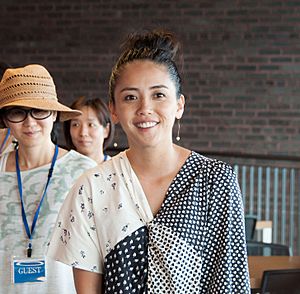Chitose Hajime facts for kids
Quick facts for kids
Chitose Hajime
元 ちとせ |
|
|---|---|
 |
|
| Background information | |
| Born | January 5, 1979 Setouchi, Kagoshima, Japan |
| Genres | Folk, World music |
| Occupation(s) | Singer |
| Years active | 1993–present |
| Labels | Central Gakki Records (1994–1997), Atsuga (2001), Epic (2001–present) |
Chitose Hajime (born January 5, 1979) is a talented Japanese singer. She comes from a beautiful island called Amami Ōshima. Chitose is known for her special singing style called shima-uta, which is unique to her home region. She often uses a high, clear voice called falsetto in her songs.
Contents
Chitose Hajime's Musical Journey
Her Early Life and Music
Chitose Hajime started learning to play the shamisen (a Japanese string instrument) when she was very young. Her mother encouraged her. By age 10, she began to learn shima-uta, a traditional singing style passed down through many generations.
As a teenager, Chitose won many folk song competitions across Japan. She released two traditional folk albums on cassette tapes with a small record company. The first one came out when she was 16. When she was 17, many record companies wanted to sign her after she won a big folk song contest.
However, Chitose was unsure about joining a record label. Instead, she decided to study to become a beautician, like her older sister. She moved to Osaka in 1997. But she had asthma and bad reactions to the chemicals used by beauticians. She left school. Before going back home to Amami Ōshima, she contacted Office Augusta, a music company that had visited her island when she was 17.
Starting Her Music Career
In March 2001, Chitose released her first mini-album with Augusta Records. This album had cover versions of songs by artists like Carole King and Jimi Hendrix. People loved it so much that she released another mini-album, Kotonoha, just five months later in August 2001. This second album had five new songs written by her.
In 2002, she released her first big single, Wadatsumi no Ki ("The Sea-God's Tree"), with Epic Records. It became a huge hit! It was the third best-selling single of the year in Japan, selling about 850,000 copies. A few months later, she released another popular single, "Kimi o Omou". This song helped her become a well-known artist.
Her first major album, Hainumikaze, came out later in 2002. It sold 800,000 copies and stayed on the music charts for 57 weeks. It was the 16th best-selling album that year.
She released three more singles before her second major album, Nomad Soul, in 2003. After a concert tour and a live album in 2004, Chitose announced she was getting married. She had her first child in 2005.
Returning to Music
Chitose returned to music in November 2005 with the single "Kataritsugu Koto". This song was the ending theme for the anime series BLOOD+. It was a hit, reaching number 12 on the Oricon charts. She then released "Haru no Katami", which was the ending theme for the anime AYAKASHI – Japanese Classic Horror.
Her third single, "Ao no Requiem", was the theme song for the film Hatsukoi (First Love). The next week, she released her third original major album, Hanadairo. A special version of this album included a song called "Shinda Onna no Ko" with famous musician Ryuichi Sakamoto.
After Hanadairo, Chitose took a break to spend time with her family and moved to Okinawa. She came back in 2008 with the song "CASSINI". This song was about family and connecting with others.
In August 2010, she released two albums at the same time: "Orient" (in Japanese) and "Occident" (in English).
The Special Sound of Chitose Hajime
Studies have shown that Chitose Hajime's unique singing style can be very relaxing. Her music includes parts of traditional Amami-Ōshima music. When people listen to her sing, their brain waves show a calming effect.
Chitose Hajime's Music
Chitose Hajime has released many albums and singles throughout her career. Here are some of her main works:
Indie Albums
- [1994] Higya Merabe (Cassette Tape)
- This album features traditional folk music songs from the Amami Islands, sung in the Amami language.
- [2002] Shima • Kyora • Umui (originally released in 1997, re-released in 2002)
- This album also contains many traditional folk songs from the Amami Islands.
- [2001] Hajime Chitose (mini album)
- This mini-album included cover songs like "Birthday" and "Sweet Jane."
- [2001] Kotonoha (mini album)
- This album featured original songs such as "Kotonoha" and "Yakusoku."
Major Albums
- [2002] Hainumikaze
- This album includes her hit single "Wadatsumi no Ki."
- [2003] Nomad Soul
- Features songs like "Sen no Yoru to Sen no Hiru" and "Itsuka Kaze ni Naru Hi."
- [2004] Fuyu no Hainumikaze (Double Disc Live Album)
- This is a live album with recordings from her concerts.
- [2006] Hanadairo
- Includes "Ao no Requiem" and "Kataritsugu Koto."
- [2008] CASSINI
- Features songs like "Cassini" and "Hotaru Boshi."
Singles
- [2002] Wadatsumi no Ki
- [2002] Kimi wo Omou
- [2002] Kono Machi
- [2003] Sen no Yoru to Sen no Hiru
- [2003] Itsuka Kaze ni Naru Hi
- [2005] Kataritsugu Koto
- [2006] Haru no Katami
- [2006] Ao no Requiem
- [2007] Anata ga Koko ni Ite Hoshii/Miyori no Mori
- [2008] Hotaru boshi
DVDs
- [2004] Music Film Hajime Chitose Live – Fuyu no Hainumikaze
- This DVD includes live performances and a "Music Film" of Chitose in Amami O-Shima.
See also
 In Spanish: Chitose Hajime para niños
In Spanish: Chitose Hajime para niños
- Boushi (TV drama) (2008)

